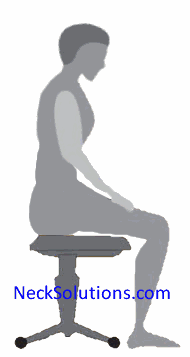The Neck Lengthening Exercise Is A Proven Method And Easy To Perform
There is considerable evidence that neck pain is associated with alterations of neck muscles and changes in muscle properties. Changes have been identified in various neck disorders and the neck flexors, deep in the front of the neck, have received particular attention as they have an important role in supporting the normal neck curve and in posture and movement. While there are many causes for neck pain, these muscles have been implicated in a variety of neck disorders and can be helped with the neck lengthening exercise.
Many factors influence the magnitude of neck pain. A relationship has been shown between neck pain intensity and activity in the neck flexor muscles. The degree of pain reduction in patients with chronic neck pain has a relationship with the change in muscle activity following exercise. Clinical trials also support the effectiveness of training these neck muscles and restoring their normal functional relationship as a component of a program for the rehabilitation of neck pain disorders. This muscular imbalance has also been implicated in poor sitting Ergonomics, which can be responsible in the development and perpetuation of neck pain symptoms.
Facilitating an upright posture activates the neck muscle group and a postural correction exercise for the neck which can be performed easily during the working day is advocated within an exercise program.

- A 2012 study in Manual Therapy Journal, the authors recruited people with persistent neck pain and demonstrated poor performance in a clinical screening of the deep neck flexor muscles.
The exercise intervention consisted of 2 weeks as a change in muscle behavior can be expected in this period. The postural exercise I like to call the Neck Lengthening Exercise was performed in sitting and required the subject to first assume an upright posture in a neutral position for the lower back. They were then taught to gently “lift the base of the skull from the top of the neck” as if to lengthen the neck. This lengthening exercise has been shown to strongly activate the deep neck flexor muscle.
They were asked to perform the exercise, holding the position for 10 seconds ideally every 15 to 20 minutes throughout their waking day, similar to a work break and exercise routine for the two week duration of the trial. The study indicated performance of the neck exercise about once per hour.
The results indicated the lengthening exercise can improve muscle performance this exercise alone would be would be sufficient to address the altered behavior of the neck flexor balance in neck pain patients.
The lengthening exercise improved cervical muscle performance and the study indicates it is a suitable option for the increasing number of people working in office environments, with a computer which can cause headaches and neck pain or other sedentary occupations. Please see related information on neck pain and computer use.
Altered working postures such as increased forward head posture implies poor function of the deep neck flexor muscles and has been indicated in those with neck pain. Improvements in the maintenance of neck posture during sustained sitting postures have been achieved with exercise of these muscles and there is a link between posture and pain.
A practical, time efficient exercise performed easily throughout the day, such as the lengthening exercise may prove an essential aspect for effective training of these muscles in those sedentary workers with neck pain.
 This study determined that training with a postural exercise, the neck lengthening exercise, consisting of assuming a neutral low back spinal posture with an added neck lengthening led to an improved pattern of neck flexor muscle activity. The authors indicated further research is necessary to explore the benefits of this exercise, these observations suggest the worth of including such an exercise in the rehabilitation of patients with neck pain disorders.
This study determined that training with a postural exercise, the neck lengthening exercise, consisting of assuming a neutral low back spinal posture with an added neck lengthening led to an improved pattern of neck flexor muscle activity. The authors indicated further research is necessary to explore the benefits of this exercise, these observations suggest the worth of including such an exercise in the rehabilitation of patients with neck pain disorders.
This is simple and easy to perform exercise and is a great start to correcting neck head posture pain. For more neck exercises, please see our introductory exercises, the following stretches. When the introductory neck exercise and stretches are mastered, exercises to improve the function of some weak muscles associated with neck pain can be looked into for strengthening muscles: trapezius myalgia exercises, postural rehab, neck pain exercises, strengthening and the neck shoulder exercise.

 Neck Traction Devices
Neck Traction Devices Cervical Pillows
Cervical Pillows Neck Support Collars
Neck Support Collars